(covers information from several alternate timelines)
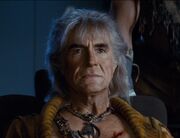
Khan Noonien Singh in 2285, the Augment tyrant and last vestige of the Eugenics Wars
"Because I am… better."
"At what?"
"Everything."
The term augment was used to describe a group of genetically-engineered Humans created by advances in DNA resequencing in the late 20th century. In the 22nd century, Klingons created their own Augments using the original augmented Human DNA. Analogous terms included superhuman and superman. (Star Trek Into Darkness; TOS: "Space Seed"; DS9: "Doctor Bashir, I Presume", "The Sound of Her Voice") In the 23rd and 24th centuries, the term Augment was sometimes used broadly as a pejorative term for any genetically enhanced being and their descendants, or to refer to any alien species who practice genetic augmentation, such as Illyrians. (SNW: "Ghosts of Illyria"; PRO: "Supernova, Part 2")
Traits[]
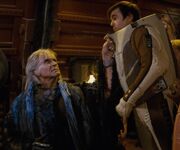
Khan lifting Pavel Chekov with one hand
The original Augments were designed to be remarkably agile, roughly five times stronger and more durable than an average Human, resistant to sickness and with enhanced senses, possessing heart muscles twice as strong and lung efficiency fifty percent better. Their blood contained platelets capable of regenerating from any disease or toxin, which could be used to cure or revive medical subjects via transfusion.
They also had twice the average human lifespan. Even their resistance to directed energy weapons was improved, as it took multiple shots with a phaser or a phase-pistol to stun one. They were even capable of resisting a Vulcan nerve pinch and mind meld. (TOS: "Space Seed"; ENT: "Borderland", "Cold Station 12"; Star Trek Into Darkness)
The Augments were also intellectually as well as physically enhanced, with their intelligence being double that of normal humans. The intelligence of an Augment was exemplified by how, within a year of being awakened in the alternate reality, Khan Noonien Singh was already capable of designing entire advanced systems of mass destruction, including the USS Vengeance, its advanced beam and missile weaponry, a propulsion system that enabled the interception of a ship while in warp, and torpedoes capable of eradicating large portions of a planet. He was able to do this despite having only outdated three-hundred-year-old technical knowledge, before being put in stasis. The ability to learn all of the latest technologies, beyond many post-doctoral qualifications, is a testament to how their artificially augmented superhuman intelligence was beyond the reach of even the most intelligent Humans. (Star Trek Into Darkness)
Despite their superior abilities, there were major defects in their genome as the Augments were belligerent, arrogant and ambitious, with a diminished sense of morality. One of the scientists behind their creation said, "Superior ability breeds superior ambition." Doctor Arik Soong later theorized that a defect in the genomes of the Augments created a malformation in the base-pair sequences that regulate the neurotransmitter levels in their brains, causing them to be highly prone to aggression and violent behavior, and considered fixing this defect before incubating some embryos. (ENT: "The Augments")
History[]
The Eugenics Wars[]
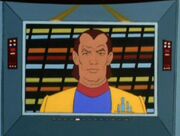
Dr. Stavos Keniclius, a genetic engineer involved in the Eugenics Wars
In the late 1950s, advances in genetic engineering were coupled with selective breeding with the aim of creating a more capable breed humans. Though the efforts succeeded, the resulting "Augments" began displaying unforeseen traits, such as aggression, savagery, and a lack of conscience. In 1992, the Augments seized power in over forty nations on Earth, leading to the conflict known to them as the Eugenics Wars, as they battled among each other and with "normal" Humans. Most of the Augments behaved as ruthless despots, treating their subjects like slaves. (TOS: "Space Seed"; Star Trek Into Darkness)
The Augments were finally overthrown in 1996; the last to be deposed was Khan Noonien Singh. After the end of the war some eighty Augments were unaccounted for, including Khan. (ENT: "The Augments"; Star Trek II: The Wrath of Khan) Earth authorities collected the remaining Augment embryos and placed them into storage; by the 2130s they were stored on the Earth Starfleet facility Cold Station 12. (ENT: "Cold Station 12") As a result of the Wars, genetic engineering was banned on Earth; scientist Stavos Keniclius who planned to clone Augments to create a master race of peacekeepers, was exiled from the planet. (TAS: "The Infinite Vulcan") Genetic enhancement was also outlawed on Earth, so as to prevent similar conflicts in the future. (DS9: "Doctor Bashir, I Presume")
Soong's Augments[]

In 2024, after his failure to create a viable human being ex nihilo, Adam Soong took an interest in Project Khan which had created the first Augments, an interest which he presumably passed down to his descendants. (PIC: "Farewell")
In the 2130s, Arik Soong, senior medical director of Cold Station 12, managed to steal several Augment embryos from the facility, which he took to the Trialas system, where he raised the resulting children as his own. A decade later he was captured by Earth forces, but refused to disclose what had happened to the embryos. (ENT: "Cold Station 12")
In May 2154 the answer to this puzzle was discovered when Soong's Augments, led by Malik, seized control of a Klingon Bird-of-Prey jettisoning its crew into space. (ENT: "Borderland")
The Klingons recovered these bodies, and discovering the Human DNA on them, threatened war. Enterprise was launched to the Borderland to find these Augments and bring them back to Earth, and Arik Soong was recruited to assist the ship in doing so.
Unfortunately, Soong managed to escape on Verex III and rejoin his Augments, who then planned to use their Bird-of-Prey to free the thousands of other embryos on Cold Station 12. (ENT: "Borderland")
With the help of Soong, Enterprise disabled the Bird-of-Prey, killing most of the Augments. Malik destroyed the ship with the remainder and managed to covertly beam to Enterprise where Captain Jonathan Archer killed him. Soong, who "defected" to Enterprise, decided afterwards to switch his focus to cybernetics. (ENT: "The Augments")
See also: The Augment Crisis
Klingon Augments[]
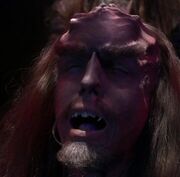
A Klingon prisoner infected with the Augment virus
After the Augment crisis, the Klingons attempted to create their own augments to combat the Humans, believing that Humans would place Augments on their ships and put the Klingons at a severe disadvantage, despite Vulcan's assurance that Earth had banned such genetic enhancement decades ago.
They were able to retrieve multiple embryos left over in the debris of the Augment Bird-of-Prey and implemented their DNA in certain Klingons. However, due to the aggressiveness of Augment DNA, the cranial ridges started to dissolve and the Klingon Augments completely lacked ridges on their foreheads.
These subjects did gain increased strength and intelligence, but they died when their neural pathways degraded. Unfortunately, one of the subjects was suffering from Levodian flu, which was modified by the Augment genes to become a deadly, airborne plague that spread throughout the Empire. An early symptom of this plague caused victims to lose the ridges on their foreheads and to look more Human. Other symptoms included irregular heartbeat, chest pain, and tingling in the cranial ridges.
A cure was eventually created by Phlox which halted the virus in the first stage, retaining the changes in appearance but with no enhanced strength, speed, or endurance. This left millions of Klingons without their ridges, an alteration that was even passed on to their children, though it was hoped that one day gene therapy would be developed to reverse the effects. (ENT: "Affliction", "Divergence"; DS9: "Trials and Tribble-ations"; TOS et al.)
The effects of this virus were reversed in at least part of the population by the 2270s. (Star Trek: The Motion Picture)
Federation Ban on Augmented Beings[]

Genetically augmented Illyrian children, seen in classified Starfleet records.
By 2259, genetically augmented beings of any species were banned from joining Starfleet, due to the dangers posed by the Eugenics Wars. The term "Augment" remained in use as a slur against genetically augmented beings and their descendants, including La'an Noonien-Singh and Illyrians like Una Chin-Riley. (SNW: "Ghosts of Illyria")
When Chin-Riley's hidden status as an augmented Illyrian was discovered while serving aboard the Enterprise, she was escorted off the ship to face trial and potential expulsion from Starfleet. (SNW: "A Quality of Mercy")
The return of Khan[]
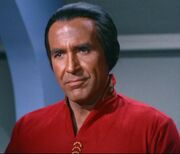
Khan Noonien Singh in 2267
The fate of Khan and his Augments remained unknown until 2267, when the USS Enterprise discovered the SS Botany Bay, a DY-100-class sleeper ship. Aboard the ship was Khan and 72 of his fellow Augments (twelve had died due to stasis unit failure in the interim). At first, the Enterprise crew was unaware of the true identity of Khan, but when it was discovered, Khan attempted to take the ship, though he ultimately failed.
Enterprise commanding officer James T. Kirk generously offered Khan and his followers voluntary exile to the uninhabited class M planet Ceti Alpha V, and Khan accepted. (TOS: "Space Seed") Unfortunately, six months later the nearby planet Ceti Alpha VI exploded, causing the orbit of Ceti Alpha V to shift, which devastated the planet's environment. The dominant remaining lifeform was the Ceti eel, which claimed many of Khan's followers.
In 2285, Khan seized control of the USS Reliant, intending to use it to destroy Kirk in revenge for what had happened to him and his people. In the end, Khan died when Reliant was destroyed by the detonation of the Genesis Device after a heated battle in the Mutara Nebula. (Star Trek II: The Wrath of Khan)
Alternate reality[]
In 2258 of the alternate reality, following Nero's destruction of Vulcan, Admiral Alexander Marcus begun a militarization conspiracy. He sought and discovered Botany Bay, revived Khan Noonien Singh and using his crew as leverage, recruited him into Section 31. Khan served Marcus under the identity of John Harrison. Marcus believed Khan's savage brilliance was required for an inevitable conflict with the Klingon Empire. In 2259, after Khan thought Marcus had executed his crew, he went rogue and put his crew inside 72 advanced long-range torpedoes, but these were apprehended by Marcus. The Admiral covertly had them loaded to the USS Enterprise with orders to fire them against Khan, but things went differently. The true nature of the torpedoes was discovered when Leonard McCoy and Carol Marcus attempted to defuse and examine one.
Khan orchestrated a bombing in London and attacked Starfleet Headquarters. He eventually murdered Marcus and crashed the severely damaged USS Vengeance into San Francisco. Spock and Uhura apprehended Khan and, following a revival of Kirk via blood transfusion from his own, he was placed back into suspended animation along with the rest of his crew. (Star Trek Into Darkness)
Continued repercussions[]
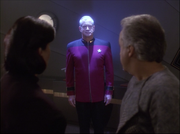
Rear Admiral Bennett sentences Richard Bashir to prison for violating eugenics laws, 2373
By 2348, genetic enhancement was outlawed by the Federation, specifically to prevent a recurrence of the Eugenics Wars and the creation of new Augments like Khan Noonien Singh. Any Federation citizens found guilty of practicing genetic resequencing to augment DNA would face the penalty of prison, and genetically enhanced people were forbidden from joining Starfleet and barred from certain professions in Federation society. (DS9: "Doctor Bashir, I Presume", "Statistical Probabilities")
In 2373, it was discovered that Julian Bashir was secretly genetically enhanced as a child by his parents to improve his mental and physical abilities. He was nearly expelled from Starfleet and forced to resign his post as a physician due to his status as a genetically enhanced human. The Judge Advocate General of Starfleet, Rear Admiral Bennett, presided over a commission convened to determine Bashir's fate. After some deliberation, they made a special exemption for Bashir to remain in Starfleet, but only if his father served prison time for his violation of eugenics laws. (DS9: "Doctor Bashir, I Presume")
Not all genetically augmented beings created in this manner were considered "superhuman". By 2374, an organization known as the Institute housed and cared for augmented humans who, like Bashir, may have acquired some enhancements or genetic alterations, but also had considerable mental or physical shortcomings as side effects of the procedure. One such augmented human, Jack, debated with Bashir over the ethics of how Augments are treated in the 24th century, suggesting that fears over the return of the Eugenics Wars led the Federation to enact a form of prejudicial treatment against them. Bashir pointed out that the fear is not entirely unfounded, as genetically enhanced humans like them "did try to take over" once before. (DS9: "Statistical Probabilities")
In 2384, Dal R'El, a purple humanoid of previously unknown origins, went through a biometeric scanner at CR-721 which was able to identify what he was. However, the scanner revealed that it was classified and instructed Dal to report to Starfleet Command. (PRO: "Asylum")
Dal later had his DNA analyzed by Dr. Jago while on Noble Isle. The geneticist identified Dal as a Human Augment, the "sloppy" product of Dr. Arik Soong's disciples who also hybridized his base DNA with the genes of 26 other species, such as Organian and Vulcan. Jago was able to use an epigenetic dermal implant to help Dal activate his dormant genes and gain enhanced abilities, but when Dal maximized the implant to deal with a team of Tal Shiar commandos, he inadvertently activated all of his dormant genes at once and destabilized his physiology. Fortunately, Zero was able to remove the implant in time and reverse the changes, although this also caused Dal to lose the enhanced abilities that he had gained. (PRO: "Masquerade")
Later, when Gwyndala informed Kathryn Janeway about Dal's dream of joining Starfleet, the vice admiral stated that it would not be allowed because Augments remained banned from entry in the aftermath of the Eugenics Wars. Ultimately, however, Janeway spoke convincingly in favor of Dal's admission into Starfleet, arguing that, along with the fact that he was simply a genetic hybrid and not enhanced, his combined DNA from many Federation species made him an apt embodiment of Federation ideals. As a result, Dal was allowed to join Starfleet as a warrant officer in training. (PRO: "Mindwalk", "Supernova, Part 2")
Known Augments[]
- See: Category: Augments
- See: List of unnamed Augments
Appendices[]
Appearances[]
The term "Augment" itself was used in the 22nd century episodes of Star Trek: Enterprise and 23rd century in Star Trek: Strange New Worlds. The term was both applied to those whose DNA was genetically engineered in the 20th century, as well as their descendants, but could also be used against other genetically modified races like the Illyrians as a pejorative. The following episodes featured Augments:
- TOS: "Space Seed"
- TAS: "The Infinite Vulcan"
- Star Trek films:
- ENT:
- ST: "Ephraim and Dot"
- SNW:
- PRO:
Apocrypha[]
Prior to the streaming of Star Trek: Picard and Star Trek: Strange New Worlds, Greg Cox's The Eugenics Wars novels depicted the Augments as being created via in vitro fertilization. The Rise and Fall of Khan Noonien Singh, Volume One states Khan was born in 1970.
In contrast, the Khan comic book series written by Mike Johnson depicts the Augments as orphaned children who were kidnapped of the streets and subjected to tests, where their genetic code was overwritten by DNA synthesized by their captors. The comic, a tie-in to Star Trek Into Darkness, is closer to the timeframe given by the film for the Augments' date of birth.
External links[]
- Augment at Memory Beta, the wiki for licensed Star Trek works
- Übermensch at Wikipedia
